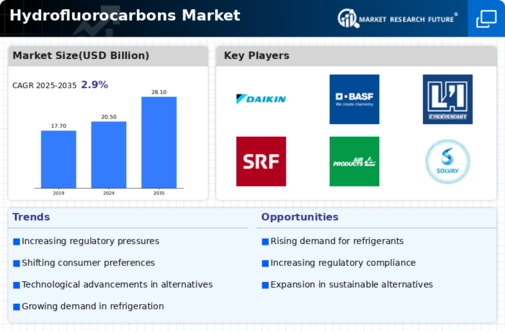Market Growth Projections
The Global Hydrofluorocarbons Market Industry is projected to experience steady growth over the coming years. With a market value anticipated to reach 20.5 USD Billion in 2024 and further increase to 28.1 USD Billion by 2035, the industry is on a positive trajectory. The compound annual growth rate (CAGR) of 2.92% from 2025 to 2035 indicates a stable expansion phase, driven by various factors including regulatory changes, technological advancements, and increasing demand in key sectors. This growth reflects the ongoing evolution of the market as it adapts to environmental challenges and consumer preferences, positioning itself for a sustainable future.
Expansion of Emerging Markets
The Global Hydrofluorocarbons Market Industry is poised for growth due to the expansion of emerging markets, particularly in Asia-Pacific and Latin America. Rapid industrialization and urbanization in these regions are driving the demand for refrigeration and air conditioning systems, which in turn fuels the need for hydrofluorocarbons. As economies develop, the adoption of modern cooling technologies becomes essential for supporting infrastructure and improving living standards. This trend is likely to create new opportunities for market players, as they seek to establish a presence in these burgeoning markets, thereby contributing to the overall growth trajectory of the industry.
Increasing Awareness of Climate Change
The Global Hydrofluorocarbons Market Industry is significantly impacted by the growing awareness of climate change and its associated risks. As public consciousness regarding environmental issues rises, consumers and businesses alike are increasingly seeking sustainable practices. This shift in mindset encourages industries to adopt greener alternatives and reduce reliance on high-GWP substances like hydrofluorocarbons. Consequently, manufacturers are compelled to innovate and offer products that align with eco-friendly standards. This trend not only fosters market growth but also enhances corporate responsibility, as companies strive to mitigate their environmental footprint in response to consumer demand for sustainability.
Technological Advancements in HFC Alternatives
The Global Hydrofluorocarbons Market Industry is witnessing significant advancements in technology aimed at developing alternatives to traditional HFCs. Innovations in low-GWP refrigerants and improved manufacturing processes are emerging as key drivers of market evolution. Companies are investing in research and development to create substitutes that maintain performance while minimizing environmental impact. This technological shift not only aligns with regulatory requirements but also meets consumer demand for sustainable solutions. As these alternatives gain traction, the market landscape is likely to transform, potentially leading to a CAGR of 2.92% from 2025 to 2035, as businesses adapt to changing preferences and regulations.
Regulatory Compliance and Environmental Standards
The Global Hydrofluorocarbons Market Industry is increasingly influenced by stringent regulatory frameworks aimed at reducing greenhouse gas emissions. Governments worldwide are implementing policies to phase down the use of hydrofluorocarbons due to their high global warming potential. For instance, the Kigali Amendment to the Montreal Protocol sets binding targets for HFC reductions, which is expected to drive innovation in alternative refrigerants. This regulatory landscape not only compels manufacturers to adapt but also creates opportunities for growth in the market, as companies invest in compliant technologies and products. As a result, the market is projected to reach 20.5 USD Billion in 2024.
Growing Demand in Refrigeration and Air Conditioning
The Global Hydrofluorocarbons Market Industry is experiencing a surge in demand driven by the refrigeration and air conditioning sectors. With rising temperatures and increasing urbanization, the need for efficient cooling solutions is paramount. Hydrofluorocarbons Market are widely utilized in these applications due to their favorable thermodynamic properties. For example, the transition to energy-efficient systems is likely to enhance the demand for HFCs, as they are integral to modern HVAC systems. This trend is expected to contribute to the market's growth, with projections indicating a value of 28.1 USD Billion by 2035, reflecting the essential role of HFCs in meeting global cooling needs.

















Leave a Comment